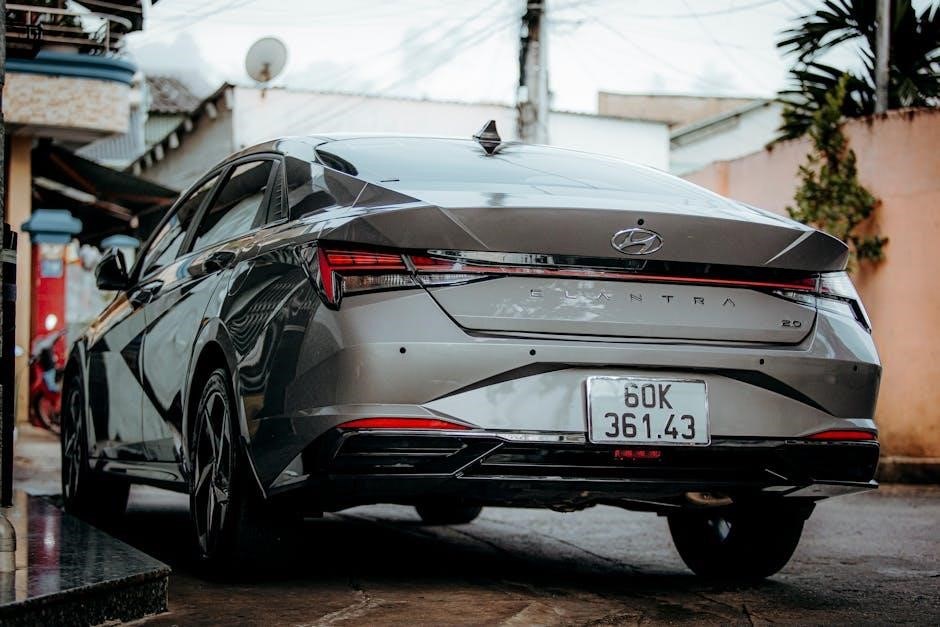Welcome to the Hyundai Elantra 2018 Owners Manual, your comprehensive guide to understanding and maintaining your vehicle. This manual provides essential information on safety, features, and maintenance to ensure optimal performance and longevity. Download the PDF version for easy access to detailed instructions and troubleshooting tips.
1.1 Purpose of the Manual
The purpose of the Hyundai Elantra 2018 Owners Manual is to introduce you to your vehicle’s features, controls, and operation. It provides essential safety information, maintenance guidelines, and troubleshooting tips to ensure optimal performance and longevity. By reading this manual, you’ll gain a deeper understanding of your car, enabling you to drive safely and enjoy its full potential. It serves as your go-to guide for any questions or concerns about your Hyundai Elantra.
1.2 Important Safety Information
This section provides critical safety information to ensure safe operation of your Hyundai Elantra. It highlights essential guidelines for driving, proper use of safety features like airbags and seatbelts, and precautions to avoid potential hazards. Reading this section carefully will help you understand how to protect yourself and your passengers while driving. Failure to follow these guidelines may increase the risk of injury or damage to your vehicle. Always prioritize safety to enhance your driving experience.
1.3 Vehicle Familiarization
Welcome to your Hyundai Elantra 2018! This section helps you get acquainted with your vehicle’s key features and components. Familiarize yourself with the exterior, including lights, mirrors, and doors, and the interior, such as seats, steering wheel, and dashboard controls. Understanding these elements will enhance your driving experience and help you utilize your car’s capabilities effectively. Take time to explore and adjust settings to ensure comfort and confidence behind the wheel.

Safety Information and Precautions
This section outlines essential safety guidelines, airbag systems, seatbelt usage, and child safety features. Proper use ensures safe vehicle operation and protection.
2.1 General Safety Guidelines
Always read and follow the instructions in this manual to ensure safe operation of your Hyundai Elantra 2018. Familiarize yourself with safety features, proper driving practices, and vehicle maintenance. Adjust mirrors and seats correctly, ensure all passengers wear seatbelts, and avoid distractions while driving. Never overload the vehicle beyond its capacity, and keep children restrained appropriately. Adhere to all safety guidelines to protect yourself and others on the road.
2.2 Airbag System Overview
The Hyundai Elantra 2018 is equipped with an advanced airbag system designed to provide optimal protection in the event of a collision. It includes front airbags, side airbags, and curtain airbags, all carefully integrated to reduce injury risk. The system is controlled by sensors that detect impact severity and trigger deployment accordingly. Always wear seatbelts, as they work in conjunction with airbags for maximum safety. Do not modify or tamper with the airbag system, and consult the manual or a certified service center for any concerns.
2.3 Seatbelt Usage and Safety
Proper seatbelt use is crucial for safety in the Hyundai Elantra 2018. Ensure all occupants wear seatbelts at all times, as they significantly reduce injury risk in collisions. The seatbelt system includes lap/shoulder belts for front and rear seats. Always wear the belt with the buckle securely fastened and the strap snug across the shoulder and chest. Avoid loose fitting or twisted belts, as this compromises protection. Never share a seatbelt, and ensure children use appropriate booster seats. Ignoring seatbelt use can lead to severe injury or legal consequences. Always follow proper usage guidelines outlined in the manual.
2.4 Child Safety Features
Child safety is a top priority in the Hyundai Elantra 2018. The vehicle is equipped with essential features to protect young passengers, including rear door locks to prevent accidental opening and ISOFIX anchor points for secure installation of child seats. Always use age-appropriate child restraints and ensure they are properly secured using the LATCH system; Refer to the manual for specific guidelines on installing and using child safety seats to ensure maximum protection for children while traveling.

Instrument Panel and Controls
The Hyundai Elantra 2018 features a user-friendly instrument panel with essential controls for navigation, climate, and entertainment. The dashboard includes a central touchscreen display, audio buttons, and climate control knobs, designed for easy access and intuitive operation while driving.
3.1 Dashboard Layout
The Hyundai Elantra 2018 dashboard is thoughtfully designed, featuring a central touchscreen display for infotainment, navigation, and vehicle settings. The layout includes a digital instrument cluster, climate control buttons, and audio controls, all within easy reach of the driver. Additional features like a steering wheel with mounted controls enhance convenience, allowing drivers to manage functions without distraction. The clean and modern design ensures optimal functionality and a seamless driving experience.
3.2 Gauges and Meters
The Hyundai Elantra 2018 features a modern instrument cluster with a speedometer, tachometer, fuel level gauge, and temperature gauge. These gauges provide clear visual feedback on vehicle performance. The central digital display offers additional information, such as odometer readings and trip meters. Warning lights indicate system status, ensuring drivers are informed of potential issues. The intuitive design allows for quick comprehension, enhancing safety and driving efficiency. These gauges and meters are essential for monitoring vehicle health and optimizing performance.
3.3 Warning Lights and Indicators
The Hyundai Elantra 2018 features a range of warning lights and indicators on the instrument panel to alert drivers of system statuses or potential issues. These include lights for low fuel, oil pressure, battery charge, and more. Color-coded for urgency, they ensure timely driver response. The manual provides a detailed reference guide to understand each light’s meaning. Always consult the manual for specific indicator interpretations to ensure safety and proper vehicle maintenance, addressing issues promptly to avoid complications.

Driving Information
The Hyundai Elantra 2018 offers a smooth driving experience with its dual-clutch transmission and various driving modes. Optimize fuel efficiency with ECO mode for city driving or switch to Sport mode for enhanced performance. The manual provides tips on transmission operation, driving techniques, and settings to ensure a safe and enjoyable journey. Proper use of these features enhances both comfort and vehicle longevity. Always refer to the manual for optimal driving practices.
4.1 Transmission Overview
The Hyundai Elantra 2018 features a dual-clutch transmission with seven forward speeds and one reverse speed, designed for smooth and efficient gear shifts. This system optimizes fuel efficiency while providing responsive acceleration. The manual transmission option allows for precise control, enhancing the driving experience. Understanding the transmission’s operation is crucial for maximizing performance and ensuring proper vehicle maintenance. Refer to the manual for detailed instructions on transmission care and optimal usage. Proper transmission maintenance ensures longevity and smooth operation. Always follow the recommended maintenance schedule.
4.2 Driving Modes and Settings
The Hyundai Elantra 2018 offers multiple driving modes, including Eco, Normal, and Sport, to tailor your driving experience. Eco mode optimizes fuel efficiency, while Sport mode enhances performance. Custom settings allow you to personalize features like steering sensitivity and transmission response. Adjust these settings through the infotainment system for a tailored experience. Consult the manual to explore all options and ensure safe, enjoyable driving. Proper use of driving modes and settings enhances both comfort and performance. Always refer to the manual for guidance.
4.3 Fuel Efficiency Tips
Maximize fuel efficiency by maintaining proper tire pressure, driving smoothly, and using Eco mode. Avoid aggressive acceleration and braking, as they reduce mileage. Regularly service your vehicle, including air filter checks, to ensure optimal performance. Remove unnecessary weight from the trunk to improve fuel economy. Plan your routes to minimize traffic and idling. Use cruise control on highways to maintain consistent speeds. Refer to the manual for additional tips tailored to your Hyundai Elantra 2018.

Maintenance and Service Schedule
The Hyundai Elantra 2018 Owners Manual provides a detailed maintenance schedule, including fluid checks, tire pressure, and battery care. Download the free PDF for easy reference and ensure optimal vehicle performance.
5.1 Recommended Maintenance Schedule
The Hyundai Elantra 2018 Owners Manual outlines a detailed maintenance schedule to ensure optimal vehicle performance. Regular servicing, including oil changes every 5,000 to 7,500 miles, tire rotations, and inspections, is essential. The manual recommends checking brake pads, air filters, and belts at specified intervals. Following this schedule helps prevent potential issues, ensuring your vehicle runs efficiently and safely. Download the PDF manual for a comprehensive guide to maintenance intervals and procedures.
5.2 Fluid Checks and Replenishment
Regular fluid checks are crucial for maintaining your Hyundai Elantra 2018. The manual recommends inspecting engine oil, coolant, transmission, brake, and windshield washer fluids. Check levels using the dipstick or reservoir markers, and top up as needed. Always use the specified fluid types to avoid damage. Improper fluid levels or wrong fluids can lead to system failures. Refer to the manual for guidance on locating fluid reservoirs and proper replenishment procedures to ensure your vehicle operates safely and efficiently.
5.3 Tire Pressure and Rotation
Proper tire pressure and rotation are essential for safety, efficiency, and tire longevity. The Hyundai Elantra 2018 manual recommends checking tire pressure monthly when tires are cold. Use the pressure specified in the manual or on the tire label. Rotate tires every 5,000 to 8,000 miles, following the pattern outlined in the manual. Uneven tread wear may indicate alignment issues. Always use the correct rotation pattern to ensure balanced performance and extend tire life.
5.4 Battery Maintenance
Regular battery maintenance ensures reliable starting and electronic system operation. Check terminals for corrosion and clean them with a wire brush if necessary. Avoid overcharging, as it can damage the battery. If the battery is more than three years old, have it tested professionally. Replace the battery if it shows signs of weakness or age. Always follow proper safety precautions when handling batteries to prevent injury or damage. Refer to the manual for specific guidelines on charging and replacement.

Features and Options
The Hyundai Elantra 2018 offers a range of advanced features designed to enhance convenience, comfort, and driving experience. Explore its innovative technology and customizable options.
6.1 Infotainment System
The Hyundai Elantra 2018 features an advanced infotainment system designed to enhance your driving experience. The system includes a touchscreen display, Bluetooth connectivity, and compatibility with Apple CarPlay and Android Auto. Users can seamlessly connect their smartphones for hands-free calls, music streaming, and navigation. The intuitive interface allows for easy access to various functions, ensuring a convenient and enjoyable ride. This system is tailored to meet modern connectivity needs, providing entertainment and functionality on the go.
6.2 Comfort and Convenience Features
The Hyundai Elantra 2018 offers a range of comfort and convenience features to enhance your driving experience. These include heated front seats, dual-zone automatic climate control, and a leather-wrapped steering wheel for added comfort. Keyless entry and push-button start provide ease of access, while cruise control and a rearview camera simplify your journey. These features ensure a comfortable and stress-free ride, catering to both driver and passenger needs.
6.3 Interior and Exterior Features
The Hyundai Elantra 2018 combines modern interior and exterior features for a refined driving experience. Inside, you’ll find premium cloth upholstery, a touchscreen infotainment system with Apple CarPlay and Android Auto compatibility, and a sleek dashboard design. The exterior features a fluid design with projector headlights, chrome accents, and alloy wheels, enhancing both style and functionality. These elements blend seamlessly to create a vehicle that balances aesthetics with practicality, ensuring a satisfying ownership experience.

Technical Specifications
The Hyundai Elantra 2018 features a dual-clutch transmission with seven forward and one reverse speed, ensuring smooth acceleration and optimal fuel efficiency, alongside robust engine performance.
7.1 Engine and Performance
The Hyundai Elantra 2018 is powered by a 2.0-liter inline-four cylinder engine, delivering 147 horsepower and 132 lb-ft of torque. It offers a choice between a six-speed manual transmission and an automatic transmission with SHIFTRONIC® for enhanced control. The dual-clutch transmission in the Elantra GT Sport model ensures quick shifts and responsive acceleration, making it ideal for drivers seeking a balance between efficiency and performance. The engine is designed for fuel efficiency, providing an estimated 28 MPG in the city and 38 MPG on the highway, making it a reliable choice for daily commuting and long drives alike.
7.2 Dimensions and Capacities
The Hyundai Elantra 2018 measures 181.9 inches in overall length, 70.9 inches in width, and 57.7 inches in height, with a wheelbase of 106.3 inches. The trunk offers 14 cubic feet of cargo space, expandable with rear seat folding. The fuel tank capacity is 12.4 gallons, ensuring extended driving range. These dimensions provide a spacious interior and ample storage, making the Elantra a practical choice for both daily commuting and road trips.

Troubleshooting Common Issues
This section helps identify and resolve common issues with your Hyundai Elantra 2018. Use the manual to diagnose symptoms, understand error codes, and find solutions. For complex problems, consult detailed guides or contact a service center.
8.1 Diagnosing Warning Lights
Warning lights on your Hyundai Elantra 2018 indicate potential issues. Refer to the Owner’s Manual to identify specific lights, such as engine, battery, or airbag warnings. Pages 120 and 60 provide detailed explanations. If a light illuminates, check the manual for troubleshooting steps or error codes. For persistent issues, consult a certified Hyundai service center to ensure proper diagnosis and repair. Regular checks can prevent major problems and maintain your vehicle’s optimal performance and safety.
8.2 Common Maintenance Issues
Common maintenance issues for the Hyundai Elantra 2018 include oil changes, tire pressure checks, and fluid replenishment. Refer to page 60 of the manual for detailed schedules. Battery maintenance and air filter replacements are also essential. Addressing warning lights promptly can prevent major repairs. Regular servicing ensures optimal performance and safety. For persistent issues, consult a certified Hyundai service center to maintain your vehicle’s health and longevity, as outlined in the manual.

Warranty and Service Information
This section provides details on the warranty coverage for your Hyundai Elantra 2018, including terms and conditions. Find information on locating authorized service centers and scheduling maintenance to ensure your vehicle remains under warranty. Refer to the manual for guidance on service requirements and maintaining your warranty coverage effectively.
9.1 Warranty Coverage Details
The Hyundai Elantra 2018 warranty provides comprehensive coverage for parts and labor under specific terms and conditions. The warranty duration varies by component, ensuring protection against defects in materials and workmanship. Details on coverage periods for the vehicle’s battery, powertrain, and anti-perforation are outlined in the manual.
For warranty-related inquiries, refer to the service information section. Authorized service centers are listed to ensure proper maintenance and warranty validation. Always follow the manual’s guidelines to maintain coverage and ensure your vehicle remains protected under the warranty agreement.
9.2 Service Center Locations
Hyundai provides a network of authorized service centers to ensure convenient maintenance and repairs. Visit the Hyundai website to find a complete list of service center locations near you. Simply enter your location or ZIP code to get accurate results.
These centers are equipped with skilled technicians and genuine parts to ensure your Elantra receives top-quality care. Regular maintenance at authorized centers also helps maintain your vehicle’s warranty and optimal performance.

Environmental Considerations
The Hyundai Elantra 2018 is designed with environmental responsibility in mind. It features fuel-efficient technologies to reduce emissions and promote eco-friendly driving. Proper disposal of materials and recycling are encouraged to minimize environmental impact. Always follow recommended maintenance practices to ensure optimal performance and sustainability.
10.1 Fuel Efficiency and Emissions
The Hyundai Elantra 2018 is engineered to deliver excellent fuel efficiency while minimizing emissions. With an estimated 28 MPG in the city and 38 MPG on the highway, it offers a cost-effective and eco-friendly driving experience. The vehicle incorporates advanced technologies, such as the inline 4-cylinder engine and Idle Stop & Go (ISG) system, to optimize fuel consumption and reduce environmental impact. Regular maintenance, as outlined in the manual, ensures the emissions control systems function properly, aligning with environmental standards.
10.2 Recycling and Disposal
The Hyundai Elantra 2018 Owners Manual emphasizes environmental responsibility in recycling and disposing of vehicle components. Proper disposal of materials like batteries, tires, and fluids is crucial to prevent environmental harm. The manual provides guidelines for recycling parts and safely handling hazardous materials. Always follow local regulations and Hyundai’s recommended procedures to ensure eco-friendly practices. This approach supports sustainability and reduces the vehicle’s environmental footprint throughout its lifecycle.
